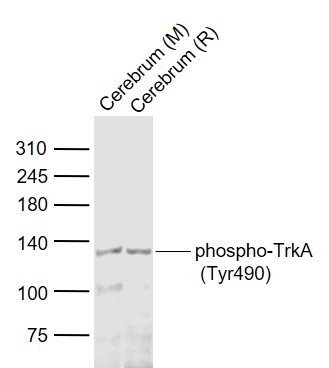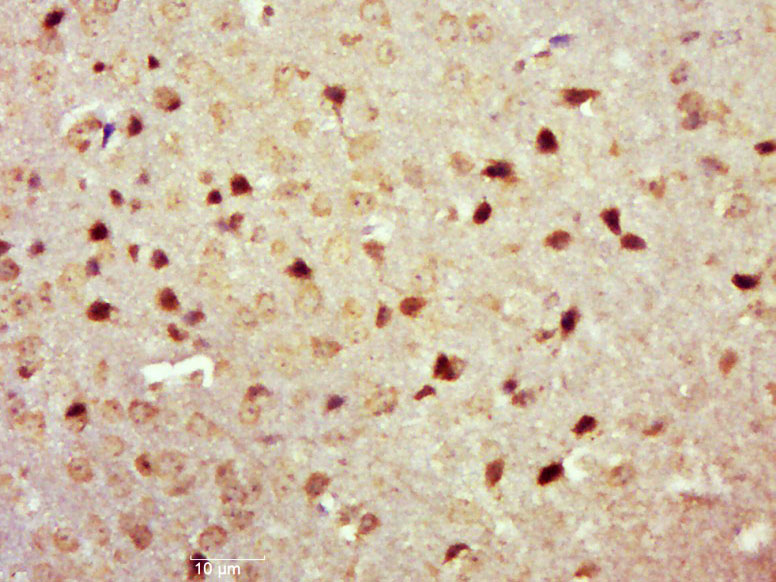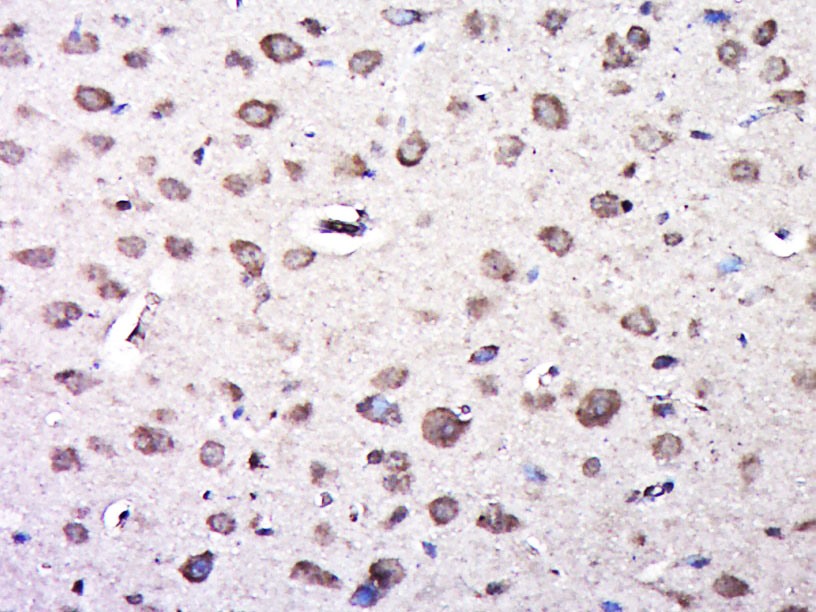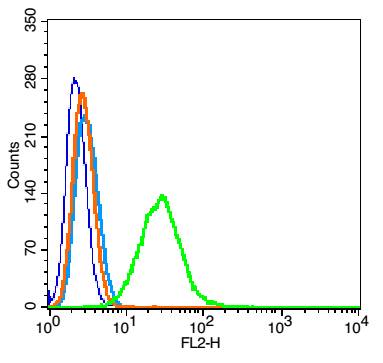
Rabbit Anti-phospho-TrkA (Tyr490)antibody
TrkA (phospho Y490); TrkA (phospho Tyr790); p-TrkA (phospho Y490); NTRK1(phospho Y490); CIPA; High affinity nerve growth factor receptor precursor; MTC; Neurotrophic tyrosine kinase receptor type 1; Ntrk 1; Ntrk1; Oncogene TRK; p140 TrkA; TRK 1; Trk A; TR
View History [Clear]
Details
Product Name phospho-TrkA (Tyr490) Chinese Name 磷酸化酪氨酸激酶A抗体 Alias TrkA (phospho Y490); TrkA (phospho Tyr790); p-TrkA (phospho Y490); NTRK1(phospho Y490); CIPA; High affinity nerve growth factor receptor precursor; MTC; Neurotrophic tyrosine kinase receptor type 1; Ntrk 1; Ntrk1; Oncogene TRK; p140 TrkA; TRK 1; Trk A; TRK; TRK1; TRK1 transforming tyrosine kinase protein; Tyrosine Receptor Kinase A. literatures Product Type Phosphorylated anti Immunogen Species Rabbit Clonality Polyclonal React Species Human, Mouse, Rat, (predicted: Chicken, Horse, Sheep, ) Applications WB=1:500-2000 ELISA=1:5000-10000 IHC-P=1:100-500 IHC-F=1:100-500 Flow-Cyt=1μg/Test IF=1:100-500 (Paraffin sections need antigen repair)
not yet tested in other applications.
optimal dilutions/concentrations should be determined by the end user.Theoretical molecular weight 90kDa Cellular localization The nucleus Form Liquid Concentration 1mg/ml immunogen KLH conjugated synthesised phosphopeptide derived from human TrkA isoform 1(790aa) around the phosphorylation site of Tyr490: PQ(p-Y)FS Lsotype IgG Purification affinity purified by Protein A Buffer Solution 0.01M TBS(pH7.4) with 1% BSA, 0.03% Proclin300 and 50% Glycerol. Storage Shipped at 4℃. Store at -20 °C for one year. Avoid repeated freeze/thaw cycles. Attention This product as supplied is intended for research use only, not for use in human, therapeutic or diagnostic applications. PubMed PubMed Product Detail The Trk family of nerve growth factor receptors includes Trk A(also referfed to as Trk A gp140),Trk B and Trk C. The prototype member of this gene family, Trk A, encodes a 140 kDa cell surface receptor , gp140, the expression of which is restricted in vivo to neurons of the sensory spinal and cranial gangliaof neurocrest origin. Nerve growth factor (NGF) stimulates tyrosine phosphorylation of Trk gp 140 in neural cell lines and in embryonic dorsal root ganglia. By comparison, BDNF and to a lesser extent, NT-3, but not NGF, can induce tyrosine phophorylayion of Trk B gp 145. The third member of the Trk receptor family, Trk C incodes a 140 kDa protein, Trk C gp140, that is preferentially expressed in brain tissue and primarily functions as a receptor for NT-3.An additional component of the Trk receptor complex, NGFR p175, binds to neurotrophic factors with low affinity but is required for efficient signaling. NGFR p175 accelerates Trk activation and may recruit downstream dffector molecules to the ligand-bound receptor complex.
Function:
Receptor tyrosine kinase involved in the development and the maturation of the central and peripheral nervous systems through regulation of proliferation, differentiation and survival of sympathetic and nervous neurons. High affinity receptor for NGF which is its primary ligand, it can also bind and be activated by NTF3/neurotrophin-3. However, NTF3 only supports axonal extension through NTRK1 but has no effect on neuron survival. Upon dimeric NGF ligand-binding, undergoes homodimerization, autophosphorylation and activation. Recruits, phosphorylates and/or activates several downstream effectors including SHC1, FRS2, SH2B1, SH2B2 and PLCG1 that regulate distinct overlapping signaling cascades driving cell survival and differentiation. Through SHC1 and FRS2 activates a GRB2-Ras-MAPK cascade that regulates cell differentiation and survival. Through PLCG1 controls NF-Kappa-B activation and the transcription of genes involved in cell survival. Through SHC1 and SH2B1 controls a Ras-PI3 kinase-AKT1 signaling cascade that is also regulating survival. In absence of ligand and activation, may promote cell death, making the survival of neurons dependent on trophic factors.
Isoform TrkA-III is resistant to NGF, constitutively activates AKT1 and NF-kappa-B and is unable to activate the Ras-MAPK signaling cascade. Antagonizes the anti-proliferative NGF-NTRK1 signaling that promotes neuronal precursors differentiation. Isoform TrkA-III promotes angiogenesis and has oncogenic activity when overexpressed.
Subunit:
Exists in a dynamic equilibrium between monomeric (low affinity) and dimeric (high affinity) structures. Homodimerization is induced by binding of a NGF dimer. Interacts with SQSTM1; bridges NTRK1 to NGFR. Forms a ternary complex with NGFR and KIDINS220; this complex is affected by the expression levels of KIDINS220 and an increase in KIDINS220 expression leads to a decreased association of NGFR and NTRK1 (By similarity). Interacts with SH2D1A; regulates NTRK1 (By similarity). Interacts (phosphorylated upon activation by NGF) with SHC1; mediates SHC1 phosphorylation and activation. Interacts (phosphorylated upon activation by NGF) with PLCG1; mediates PLCG1 phosphorylation and activation. Interacts (phosphorylated) with SH2B1 and SH2B2. Interacts with GRB2. Interacts with PIK3R1. Interacts with FRS2. Interacts with SORT1; may regulate NTRK1 anterograde axonal transport. Interacts with RAB7A.
Subcellular Location:
Cell membrane; Single-pass type I membrane protein. Early endosome membrane; Single-pass type I membrane protein. Note=Internalized to endosomes upon binding of NGF or NTF3 and further transported to the cell body via a retrograde axonal transport.
Tissue Specificity:
Isoform TrkA-I is found in most non-neuronal tissues. Isoform TrkA-II is primarily expressed in neuronal cells. TrkA-III is specifically expressed by pluripotent neural stem and neural crest progenitors.
DISEASE:
Congenital insensitivity to pain with anhidrosis
Thyroid papillary carcinoma
Similarity:
Belongs to the protein kinase superfamily. Tyr protein kinase family. Insulin receptor subfamily.
Contains 2 Ig-like C2-type (immunoglobulin-like) domains.
Contains 2 LRR (leucine-rich) repeats.
Contains 1 LRRCT domain.
Contains 1 protein kinase domain.
SWISS:
P04629
Gene ID:
4914
Database links:Entrez Gene: 4914 Human
Entrez Gene: 18211 Mouse
Omim: 191315 Human
SwissProt: P04629 Human
SwissProt: Q3UFB7 Mouse
Unigene: 406293 Human
Unigene: 80682 Mouse
Unigene: 39098 Rat
Product Picture
Lane 1: Cerebrum (Mouse) Lysate at 40 ug
Lane 2: Cerebrum (Rat) Lysate at 40 ug
Primary: Anti-phospho-TrkA (Tyr490) (SL17445R) at 1/1000 dilution
Secondary: IRDye800CW Goat Anti-Rabbit IgG at 1/20000 dilution
Predicted band size: 130 kD
Observed band size: 130 kD
Paraformaldehyde-fixed, paraffin embedded (Mouse brain); Antigen retrieval by boiling in sodium citrate buffer (pH6.0) for 15min; Block endogenous peroxidase by 3% hydrogen peroxide for 20 minutes; Blocking buffer (normal goat serum) at 37°C for 30min; Antibody incubation with (phospho-TrkA (Tyr490)) Polyclonal Antibody, Unconjugated (SL17445R) at 1:500 overnight at 4°C, followed by a conjugated secondary (sp-0023) for 20 minutes and DAB staining.Paraformaldehyde-fixed, paraffin embedded (Rat brain); Antigen retrieval by boiling in sodium citrate buffer (pH6.0) for 15min; Block endogenous peroxidase by 3% hydrogen peroxide for 20 minutes; Blocking buffer (normal goat serum) at 37°C for 30min; Antibody incubation with (phospho-TrkA (Tyr490) ) Polyclonal Antibody, Unconjugated (SL17445R) at 1:500 overnight at 4°C, followed by a conjugated secondary (sp-0023) for 20 minutes and DAB staining.Blank control(blue): RSC96 cells (fixed with 2% paraformaldehyde (10 min) , then permeabilized with 90% ice-cold methanol for 30 min on ice).
Primary Antibody:Rabbit Anti-phospho-TrkA (Tyr490) antibody(SL17445R), Dilution: 0.2μg in 100 μL 1X PBS containing 0.5% BSA;
Isotype Control Antibody: Rabbit IgG(orange) ,used under the same conditions );
Secondary Antibody: Goat anti-rabbit IgG-PE(white blue), Dilution: 1:200 in 1 X PBS containing 0.5% BSA.
References (0)
No References
Bought notes(bought amounts latest0)
No one bought this product
User Comment(Total0User Comment Num)
- No comment






 +86 571 56623320
+86 571 56623320
 +86 18668110335
+86 18668110335

